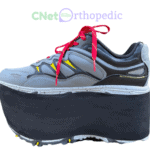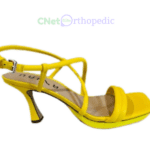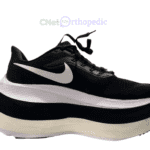1) What are orthopedic shoe lifts?

A: Orthopedic shoe build up are inserts that are placed inside a shoe to add height or raise one heel higher than the other. They are typically used to correct leg length discrepancies, or to relieve pain and discomfort caused by conditions such as plantar
2) Can I wear orthopedic shoe elevation in any type of shoe?

A: Yes, orthopedic footwear can be used in any type of shoe. They can be used in athletic shoes, dress shoes, boots, and more. Wearing orthopedic shoe elevations like heel lifts in any type of shoe requires careful consideration of several factors:
Interior Space: Not all shoes have enough interior space to accommodate an orthopedic elevation without compromising comfort. Shoes with a tight or low-volume interior might not be suitable
3) Do I need orthopedic shoe modifications?

A: If you have a leg length discrepancy, or if you are experiencing pain or discomfort in your feet, legs, or back, it may be beneficial to speak with a healthcare professional about the use of orthopedic shoe lifts. They can help determine if the use of
4) Modifications are covered by insurance?
A: Coverage for orthopedic custom lifts will depend on your specific insurance plan. It is best to check with your insurance provider to determine if the use of shoe lifts is covered under your plan. (CNETORTHOPEDIC LLC currently do not accept insurance as form of payment)
5) Are there any side effects for using shoe lifts modifications?
A: Some people may experience temporary discomfort or pain when first starting to wear orthopedic shoe lifts. However, these symptoms should subside as the body adjusts to the shoe lift. If you experience persistent discomfort or pain, you should contact your healthcare professional for guidance.
8) How do I know what size orthopedic shoe do I needed?

A: The size of the shoe modification will depend on the size of your shoe, as well as the amount of lift that you need. It is important to measure both feet and choose the size that will provide the most comfortable and effective fit.
9) Can I wear orthopedic shoe lifts if I have flat feet?
A: Orthopedic shoe lifts may be beneficial for individuals with flat feet as they can help to alleviate pain and discomfort caused by the condition. However, it is important to speak with a healthcare professional to determine if the use of shoe lifts is appropriate for your specific case.
10) Can children wear orthopedic shoe lifts?
A: Yes, children can wear orthopedic shoe lifts if they have a leg length discrepancy or if they are experiencing pain or discomfort in their feet, legs, or back. However, it is important to have the child evaluated by a healthcare professional to determine if the use of shoe lifts is appropriate and what size and type of shoe lift is needed.
11) Are you a legit company who we can trust?
A: Yes, we are a legit company registered in the State of Ohio. (Cnetorthopedic LLC)
13) What form of payment does CNETORTHOPEDIC accept currently?
A: We currently accepts: All major Credit Cards, Debit Cards, HSA Debit Cards (Health Savings Account) Checks, PayPal, Apple Pay, Google Pay and Cash in our office at: 5567 Ridge Rd Parma, OH 44129
14) Do I have to pay for shipping when I send my shoe(s) to CNETORTHOPEDIC?
A NO, we pay for shipping back and forth, however this only applies to the shoe that needs to be modified.
15) What does a shoe lift do?
A: A shoe lift, also known as a heel lift or shoe wedge, is an insert that is placed inside a shoe to add height to the heel. They can be used to correct leg length discrepancies, alleviate back pain caused by an uneven gait, or simply to add height to the wearer. Shoe lifts can be made from a variety of materials, including foam, cork, or gel, and come in a range of thicknesses to provide the desired amount of lift. They can be worn in most types of shoes, including athletic shoes, dress shoes, and boots, and are often used by people with conditions such as leg length discrepancy, spinal injuries, and certain types of arthritis.
17) When should you get a orthopedic shoe ?
A: When considering getting a shoe lift, it is important to consult with a healthcare professional or a podiatrist first. A shoe lift may be recommended for individuals who have a leg length discrepancy, which can occur due to a congenital condition, injury, or disease. A leg length discrepancy can cause an uneven gait and lead to back, hip, and knee pain. A shoe lift can help alleviate these symptoms by adjusting the height of the heel to even out leg length. Additionally, shoe lifts may be recommended for individuals who have spinal injuries or certain types of arthritis, as these conditions can also cause pain and discomfort. A shoe lift can help reduce pain and improve mobility in these cases. It’s important to note that a shoe lift is not a solution for everyone and it’s best to consult with a professional before making a decision.
18) How much does it cost to put a lift on a shoe?
A: The cost of adding a lift to a shoe can vary depending on a few factors. If you need to have a lift custom made for your shoe or foot, it can be more expensive. Custom made lifts are specially crafted to fit a specific shoe and foot, which can make them more comfortable and effective than off-the-shelf options. Custom made lifts usually cost between $50 to $200, depending on the material used and the complexity of the design. On the other hand, pre-made shoe lifts are readily available and they can be found at most drugstores and online retailers, with prices ranging from $10 to $50. The materials used in pre-made lifts are foam, cork, gel, etc. It is important to note that it is not always necessary to get a custom-made lift, pre-made lifts can also work well for many people. However, it’s best to consult with a professional before making a purchase, to ensure that the lift you choose will be the most suitable for your needs.
19) How long does a shoe lift last?
A: The lifespan of a shoe lift will depend on several factors such as the type of material used, how frequently it is worn, and how well it is maintained.
Pre-made shoe lifts which are made from foam or cork materials tend to last for several months to a year, depending on how often they are worn and how well they are cared for. They can become compressed over time and lose their effectiveness, or they may become damaged if not handled properly. It’s important to note that these types of shoe lift can lose their shape over time, especially if they are exposed to excessive heat or humidity.
Custom-made shoe lifts, which are usually made of higher-quality materials such as leather, carbon fiber, or polypropylene, tend to last longer than pre-made lifts. They can last between 1 to 2 years or even more if they are well-maintained. They are usually more durable and resistant to wear and tear, they are also more resistant to shape loss.
Regardless of the type of shoe insert, it is important to take good care of them to make them last as long as possible. This means keeping them clean, dry, and protected from damage, and avoiding exposure to excessive heat or humidity. It’s also important to note that it’s always best to check with your healthcare professional or podiatrist if you notice any changes or need a replacement.
20) Are shoe elevations are healthy?
Shoe lifts, also known as heel lifts or shoe inserts, are small inserts that can be placed inside a shoe to add height to the heel. They are often used by individuals who have one leg shorter than the other. While shoe lifts can help to alleviate pain and discomfort caused by leg length discrepancy, they may also cause problems if not used properly. It is important to consult with a healthcare professional before using shoe lifts, as they can affect the alignment of the spine and cause strain on the knee and ankle joints. Additionally, it is recommended to use shoe lifts only for a short period of time, and to gradually increase the height of the lift to avoid injury.